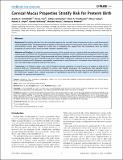| dc.contributor.author | Critchfield, Agatha S. | |
| dc.contributor.author | Yao, Grace | |
| dc.contributor.author | Jaishankar, Aditya | |
| dc.contributor.author | Lieleg, Oliver | |
| dc.contributor.author | Doyle, Patrick S. | |
| dc.contributor.author | House, Michael | |
| dc.contributor.author | Ribbeck, Katharina | |
| dc.contributor.author | Friedlander, Ronn Samuel | |
| dc.contributor.author | McKinley, Gareth H. | |
| dc.date.accessioned | 2013-09-27T16:00:20Z | |
| dc.date.available | 2013-09-27T16:00:20Z | |
| dc.date.issued | 2013-08 | |
| dc.date.submitted | 2013-03 | |
| dc.identifier.issn | 1932-6203 | |
| dc.identifier.uri | http://hdl.handle.net/1721.1/81216 | |
| dc.description.abstract | Background:
Ascending infection from the colonized vagina to the normally sterile intrauterine cavity is a well-documented cause of preterm birth. The primary physical barrier to microbial ascension is the cervical canal, which is filled with a dense and protective mucus plug. Despite its central role in separating the vaginal from the intrauterine tract, the barrier properties of cervical mucus have not been studied in preterm birth.
Methods and Findings:
To study the protective function of the cervical mucus in preterm birth we performed a pilot case-control study to measure the viscoelasticity and permeability properties of mucus obtained from pregnant women at high-risk and low-risk for preterm birth. Using extensional and shear rheology we found that cervical mucus from women at high-risk for preterm birth was more extensible and forms significantly weaker gels compared to cervical mucus from women at low-risk of preterm birth. Moreover, permeability measurements using fluorescent microbeads show that high-risk mucus was more permeable compared with low-risk mucus.
Conclusions:
Our findings suggest that critical biophysical barrier properties of cervical mucus in women at high-risk for preterm birth are compromised compared to women with healthy pregnancy. We hypothesize that impaired barrier properties of cervical mucus could contribute to increased rates of intrauterine infection seen in women with preterm birth. We furthermore suggest that a robust association of spinnbarkeit and preterm birth could be an effectively exploited biomarker for preterm birth prediction. | en_US |
| dc.description.sponsorship | Massachusetts Institute of Technology. Charles E. Reed Faculty Initiative Fund | en_US |
| dc.description.sponsorship | Burroughs Wellcome Fund (Preterm Birth Research Grant) | en_US |
| dc.description.sponsorship | National Science Foundation (U.S.). Graduate Research Fellowship Program | en_US |
| dc.language.iso | en_US | |
| dc.publisher | Public Library of Science | en_US |
| dc.relation.isversionof | http://dx.doi.org/10.1371/journal.pone.0069528 | en_US |
| dc.rights | Creative Commons Attribution | en_US |
| dc.rights.uri | http://creativecommons.org/licenses/by/2.5/ | en_US |
| dc.source | PLoS | en_US |
| dc.title | Cervical Mucus Properties Stratify Risk for Preterm Birth | en_US |
| dc.type | Article | en_US |
| dc.identifier.citation | Critchfield, Agatha S., Grace Yao, Aditya Jaishankar, Ronn S. Friedlander, Oliver Lieleg, Patrick S. Doyle, Gareth McKinley, Michael House, and Katharina Ribbeck. “Cervical Mucus Properties Stratify Risk for Preterm Birth.” Edited by Tamas Zakar. PLoS ONE 8, no. 8 (August 1, 2013): e69528. | en_US |
| dc.contributor.department | Whitaker College of Health Sciences and Technology | en_US |
| dc.contributor.department | move to dc.description.sponsorship | en_US |
| dc.contributor.department | Harvard University--MIT Division of Health Sciences and Technology | en_US |
| dc.contributor.department | Massachusetts Institute of Technology. Department of Biological Engineering | en_US |
| dc.contributor.department | Massachusetts Institute of Technology. Department of Chemical Engineering | en_US |
| dc.contributor.department | Massachusetts Institute of Technology. Department of Mechanical Engineering | en_US |
| dc.contributor.mitauthor | Yao, Grace | en_US |
| dc.contributor.mitauthor | Lieleg, Oliver | en_US |
| dc.contributor.mitauthor | Ribbeck, Katharina | en_US |
| dc.contributor.mitauthor | Friedlander, Ronn Samuel | en_US |
| dc.contributor.mitauthor | Jaishankar, Aditya | en_US |
| dc.contributor.mitauthor | McKinley, Gareth H. | en_US |
| dc.contributor.mitauthor | Doyle, Patrick S. | en_US |
| dc.relation.journal | PLoS ONE | en_US |
| dc.eprint.version | Final published version | en_US |
| dc.type.uri | http://purl.org/eprint/type/JournalArticle | en_US |
| eprint.status | http://purl.org/eprint/status/PeerReviewed | en_US |
| dspace.orderedauthors | Critchfield, Agatha S.; Yao, Grace; Jaishankar, Aditya; Friedlander, Ronn S.; Lieleg, Oliver; Doyle, Patrick S.; McKinley, Gareth; House, Michael; Ribbeck, Katharina | en_US |
| dc.identifier.orcid | https://orcid.org/0000-0001-8260-338X | |
| dc.identifier.orcid | https://orcid.org/0000-0001-8323-2779 | |
| mit.license | PUBLISHER_CC | en_US |
| mit.metadata.status | Complete | |
